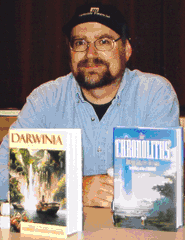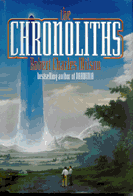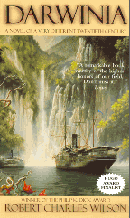  | ||||
HOME |
Exploring the Strangeness of Life [The following interview of Robert Charles Wilson was conducted by e-mail in August, 2001 and published in the September/October 2001 issue of The Voyageur. Photo taken by Paul Bobbitt on October 20, 2001.] Are you going on a book-signing tour with The Chronoliths? I understand you've been on at least one tour before, with Robert Sawyer, and had some interesting experiences. There won't be a formal tour for this book, though I've already done some ad-hoc out-of-town signings, most recently at the Toadstool Bookstore in New Hampshire and at Worldcon. I toured with Rob when my Darwinia and his Factoring Humanity had just been released. And yes, we were booked into some unusual gigs. An African-American gospel radio station in Detroit interviewed us, for instance, and that turned out to be a surprisingly generous and intelligent exchange, though I'm not sure how many books it sold. And there was the ultraconservative woman in Tacoma who runs a radio show out of a booth in a local mall—a nice enough person despite her nutty politics and her astonishingly close resemblance to Dame Edna. (I hope she isn't reading this!) On a call-in show in Vancouver, we were quizzed about our opinions of crop circles and chided for our skepticism. Touring a book is a weird experience. Unless you happen to be Stephen King or Tom Clancy, you occupy the lowest and most trivial rung of the "celebrity" ladder. Staggering through airports at odd hours, sleeping in hotel rooms somebody else has been kind enough to pay for, repeating the same modestly-self-promoting pitch and reading the same passages until the words lose all meaning...confronting the bleak truth that what you thought of as Creating at least a kind of Literature has been reduced to the act of advertising mass-market paper products. And not doing it very brilliantly. In The Chronoliths, when a 21st-century Earth is devastated by the appearance of huge pillars that are memorials to conquest 20 years in the future, a software designer, an undercover agent and an experimental physicist join forces to find a way to change the future. You addressed time travel paradoxes in A Bridge of Years (1991) as well. Was there an unscratched itch that led you to revisit the time travel theme? In a sense, yes, though I never thought of it precisely that way. Anyone who sits down to write a time-travel story has to deal with the problem of paradox, if only by sweeping it under the carpet. I wanted to confront it directly, without benefit of alternate histories and other such dodges, and it occurred to me that an object that had travelled backward in time would be immediately distinguishable as such. Where other objects have an indeterminate future, a Chronolith would have an indeterminate past. That is, seen from the present, the Chronolith is an absolutely pre-determined event. Whatever else might happen, the Chronolith will persist. Viewed from the future, its past becomes fluid and unknowable.
What kind of research did you do before writing The Chronoliths? Much of the research was geographic. Baedecker research, as Thomas Pynchon once called it. I had to fake a plausible knowledge of Thai beach culture and the near future of Israel and Jerusalem (and Minneapolis, come to that). My editor at Tor, Teresa Nielsen-Hayden, read the first draft of the book and pointed me gently at some material that proved useful. Running in the background of the book's 21st century are a couple of slow-burning disasters that may actually happen. One is the natural diversion of the Mississippi River into the Atchafalaya Basin. The Mississippi delta is slowly but inevitably silting up, and the Atchafalaya River is digging itself a deeper basin out of consolidating clays. All the water currently flowing into the Gulf of Mexico from the Mississippi will sooner or later be diverted into the Atchafalaya. The result will be floods, economic displacement, and a devastating blow to the economy of the New South...unless the Army Corps of Engineers comes up with something really clever. The other slow-burning disaster is the depletion of the Oglalla Aquifer, an underground body of water that makes agriculture possible in much of dry western United States. The aquifer is a finite resource and is receding fast. This will result in a farm crisis—and probably a great deal of pressure on Canada to sell our water resources southward. What are you working on now? I'm working on a novel called Blind Lake. Without going into detail, it deals with the next great breakthrough in astronomical observation—a self-creating, self-modifying quantum telescope that allows intimate observation of the details of life on another inhabited planet. Every astronomical breakthrough, from Copernicus and Galileo to the Hale Observatory and the Hubble Space Telescope, has rewritten the way we imagine our place in the universe. What could we deduce of a culture in the absence of any two-way communication? Could we even hope to decode their cultural symbols? How would we deal with the knowledge that, if we're watching them, any number of similarly advanced cultures might be watching us? I believe that Frank Tipler's 1994 book The Physics of Immortality: Modern Cosmology, God and the Resurrection of the Dead inspired some of your fiction, as it did that of other SF writers. What more recent books are providing you with inspiration for stories?
The cover art to your novels strikes me as exceptionally beautiful and faithful to content. This must seem like a blessing that can't be taken for granted. Which of your books has your favourite cover? I have been extremely lucky with cover art. I guess my favourite is still Jim Burns' cover for Darwinia. The ending of Darwinia left room for a sequel. Will there be one? I've fended off this question more than once. No firm plans, but I don't rule out the idea, either. Do you have some favourite characters about whom you'd like to write more stories?
If you could collaborate with another (living) writer, who would it be? I have actually done some collaboration with a writer named Marc Zicree (author of The Twilight Zone Companion, among others). He came up with an interesting premise and collaborated on it with three writers: Barbara Hambly, Maya Kaathryn Bonhoff, and myself. The first volume of this three-book series, Magic Time, should be out early in 2002. Fun work in its way, but I would think twice about doing any more collaborating. I have my own damn books to write. One of Jim Gardner's hobbies is kung fu. Share some of your hobbies with us. What do you like to do when your head's not in the computer? Okay, but this is a weird one: I love to refurbish and scratch-build vacuum-tube audio equipment. Call it a kind of passive time-travelling. American audio technology reached a peak of elegance and functionality just about the time the transistor replaced the tube—late Fifties to mid-late Sixties. Also, perhaps not coincidentally, this was the time when consumer electronics manufacturing shifted largely to Asia. But vacuum-tube gear is relatively simple to construct and can produce sound as good as or better than anything available today. Ironically, North American tube gear of 40 to 50 years ago is now highly collectable and commands high prices in Japan. That old Marantz or Dynaco tube gear your grandfather owned may now be selling for millions of yen in the Akihabara. Life is strange. Also on this site: "The Speculative Torontos of Robert Charles Wilson and Robert J. Sawyer." | |||
Interviews, Speeches, Articles | Voyageur Home Upcoming Events & Conventions | Club History Main Site Editor & Site Problems IDIC Home Copyright © 2001, Infinite Diversity International Corporation. All rights reserved. | ||||


 I described it in the book as "a zone of absolute determinacy, surrounded by a froth of ephemera (human lives, for instance) which deformed to fit its contours." That—plus the notion of conceiving the social effects of the Chronoliths as a positive-feedback loop—constitutes my contribution to Time Travel 101.
I described it in the book as "a zone of absolute determinacy, surrounded by a froth of ephemera (human lives, for instance) which deformed to fit its contours." That—plus the notion of conceiving the social effects of the Chronoliths as a positive-feedback loop—constitutes my contribution to Time Travel 101. Currently I'm reading Stuart Kaufmann's At Home in the Universe, which is extremely fertile material. And lots of texts on astrobiology.
Currently I'm reading Stuart Kaufmann's At Home in the Universe, which is extremely fertile material. And lots of texts on astrobiology. I do occasionally revisit characters. My collection of Toronto stories (The Perseids and Other Stories, which is a finalist for the World Fantasy Award this year) was in some ways an excuse to shift characters from the background of one story to the foreground of another. And I revisited Zoe Fisher, the main character of Bios, in a short story called "The Dryad's Wedding," which appeared in David Hartwell's Year's Best SF this summer. I'm working on another Bios-universe story right now. Bios itself ended semi-tragically—much to the chagrin of certain readers—but it contains the nugget of more and larger narratives.
I do occasionally revisit characters. My collection of Toronto stories (The Perseids and Other Stories, which is a finalist for the World Fantasy Award this year) was in some ways an excuse to shift characters from the background of one story to the foreground of another. And I revisited Zoe Fisher, the main character of Bios, in a short story called "The Dryad's Wedding," which appeared in David Hartwell's Year's Best SF this summer. I'm working on another Bios-universe story right now. Bios itself ended semi-tragically—much to the chagrin of certain readers—but it contains the nugget of more and larger narratives.